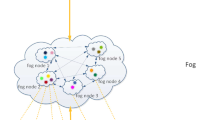Abstract
The goal of the SPICE project is to develop an extendable overlay architecture and framework to support easy and quick creation, and deployment of Telecommunication and Information Services. The SPICE Service Creation Environment (SCE) is used by developers to create both basic services and complex service compositions, which are then deployed in the SPICE Service Execution Environment (SEE), which hide the complexity of the communication environment. Along with its functional interface, each service exposes its own nonfunctional properties (like Response Time, Cost, Availability, etc...) by means of the SPATEL service description language. These properties are defined in an ontology and this chapter will discuss how the SCE helps developers in evaluating a service composition by calculating the aggregated values of such properties.
Access this chapter
Tax calculation will be finalised at checkout
Purchases are for personal use only
Preview
Unable to display preview. Download preview PDF.
Similar content being viewed by others
References
S. Tarkoma, B. Bharat, E. Kovacs, H. van Kranenburg, E. Postmann, R. Seidl, A. Zhdanova, “SPICE: A Service Platform for Future Mobile IMS Services,” in Proceedings of IEEE International Symposium on World of Wireless, Mobile and Multimedia Networks (WoWMoM 2007), June 2007, pp: 1-8, ISBN: 978-1-4244-0993-8.
OMG, “Model Driven Architecture”. Web link: http://www.omg.org/mda/
M. Belaunde, J.M. Presso, Vision for an industrial application of MDD in the Telecommunications Industry, ECMDA'05 Conference, Springer July 2005.
P. Falcarin, C. Venezia: “Communication Web Services and JAIN-SLEE Integration Challenges”. In Journal of Web Services Research (JWSR), Vol. 5(4), IGI-Global, 2008, ISSN 1545-7362.
SPICE (Service Platform for Innovative Communication Environment) project homepage. On-line at http://www.ist-spice.org/
M. Belaunde, P. Falcarin, “Realizing an MDA and SOA marriage for the development of Mobile Services”, European Conference On Model Driven Architecture, June 2008, Springer.
C. Villalonga, M. Strohbach, N. Snoeck, M. Sutterer, M. Belaunde, E. Kovacs, A.V. Zhdanova, L.W. Goix, O. Droegehorn, “Mobile Ontology: Towards a Standardized Semantic Model for the Mobile Domain,” in Telecom Service Oriented Architectures Workshop (TSOA2007), September 2007, to appear on Springer LNCS.
JAIN-SLEE API Specification. Java Community Process website: http://jcp.org/aboutJava/communityprocess/final/jsr022/index.html
Java 2 Enterprise Edition. http://java.sun.com/javaee/
Zhang, R., Arpinar, I.B., Aleman-Meza, B.: Automatic composition of semantic web services. In IEEE ICWS. (2003), pp 38–41.
M.P. Papazoglou, D. Georgakopoulos, “Service-Oriented Computing,” Communications of the ACM, October 2003, Vol. 46, n. 10, pp. 25-28.
J. O’Sullivan, D. Edmond, A.H.M. ter Hofstede, “What’s in a service? Towards accurate description of non-functional service properties”, Distributed and Parallel Databases, 2002, pp. 117-133, Kluwer ed.
K. Fujii, T. Suda, “Semantics-Based Dynamic Service Composition,” IEEE Journal on Selected Areas of Communications, v. 23(12), December 2005, pp. 2361-2372.
Web Ontology Language specification. On-line at http://www.w3.org/2004/OWL/
M.C. Jaeger, G. Rojec-Goldmann, G. Muhl, "QoS Aggregation in Web Service Compositions", IEEE International Conference on e-Technology, e-Commerce and e-Service (EEE'05), 2005, pp. 181-185.
BPEL, Business Process Execution Language for Web Services. On-line at http://www.ibm.com/developerworks/library/specification/ws-bpel/.
OMG, "MOF 2.0 Query/Views and Transformations", http://www.omg.org/spec/QVT/1.0/
W3C/VoiceXML Forum: Voice Extensible Markup Language, www.voicexml.org
W3C, Web Service Definition Language (WSDL), www.w3.org/TR/wsdl
ITU-T, Specification Definition Language (SDL). Web link: www.itu.int/ITU-T
W3C: Semantic Annotations for WSDL and XML Schema, W3C Recommendation, 28 August 2007. Web link www.w3.org/2002/ws/sawsdl/
OMG, Uml Profile And Metamodel for Services RFP, http://www.omg.org/cgibin/doc?soa/06-09-09, September 2009
A. Bosca, G. Valetto, R. Maglione, F. Corno; “Specifying Web Service Compositions on the Basis of Natural Language Requests” ICSOC’05 3rd International Conference on Service Oriented Computing, Amsterdam, December 2005
Semantic Markup for Web Services (OWL-S), http://www.w3.org/Submission/OWL-S/
OMG, "Meta Object Facility V2.0", http://www.omg.org/spec/MOF/2.0
Web Service Semantics (WSDL-S), www.w3.org/Submission/WSDL-S/
Agarwal, V., Dasgupta, K., Karnik, N., Kumar, A., Kundu, A., Mittal, S., and Srivastava, B. A service creation environment based on end to end composition of Web services. In Proceedings of the 14th international Conference on World Wide Web (2005). ACM Press, New York, NY, 128-137.
Philippe Larvet, “Automatic Orchestration of Web Services Through Semantic Annotations”, ICEIS 2007, 9th International Conference on Enterprise Information Systems, June 2007.
Jos de Bruijn, Christoph Bussler, Dieter Fensel, Michael Kifer, Jacek Kopecky, Rubn Lara, Eyal Oren, Axel Polleres, and Michael Stollberg. Web Services Modeling Ontology (WSMO). http://www.wsmo.org/
Yu, T., Kwei-Jay, L.: Service Selection Algorithms for Web-Services with End-to-End QoS Constraints. Information Systems and E-Business Management 3(2): 103-126 (2005)
L. Zeng, B. Benatallah, M. Dumas, J. Kalagnanam, and Q.Z. Sheng. Quality Driven Web Services Composition. In Proceedings of the 12th International Conference on the World Wide Web (WWW), Budapest, Hungary, May 2003. ACM Press.
Acknowledgments
This work has been performed in the framework of the IST project IST-2005-027617 SPICE, which was partly funded by the European Union. Special thanks to all project partners, and in particular to Mariano Belaunde (Orange Labs), Federico Mura, Alessio Bosca (Politecnico di Torino), Mazen Malek Shiaa (NTNU Trondheim), and Anne Marte Hjemas (Telenor).
Author information
Authors and Affiliations
Corresponding author
Editor information
Editors and Affiliations
Rights and permissions
Copyright information
© 2009 Springer-Verlag US
About this chapter
Cite this chapter
Falcarin, P. (2009). Service Composition Quality Evaluation in SPICE Platform. In: Zhang, LJ., Paul, R., Dong, J. (eds) High Assurance Services Computing. Springer, Boston, MA. https://doi.org/10.1007/978-0-387-87658-0_5
Download citation
DOI: https://doi.org/10.1007/978-0-387-87658-0_5
Published:
Publisher Name: Springer, Boston, MA
Print ISBN: 978-0-387-87657-3
Online ISBN: 978-0-387-87658-0
eBook Packages: Computer ScienceComputer Science (R0)




